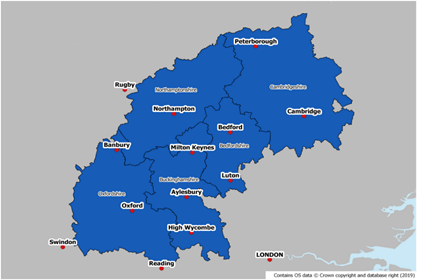
Most previous debates regarding emission reductions focussed on what the UK could achieve from the exploitation of national resources, from building large nuclear plants to the roll-out of onshore and offshore wind farms, without necessarily exploring the contributions and limitations of regional and local energy systems.
With the net zero target in place, far more emphasis is likely to be placed on the role of regional and local energy systems. For modeller this means developing models that are able to capture the spatial and temporal intricacies of these systems and their interactions with transmission/national networks. Also, it must be stressed that all energy vectors should be evaluated in order to meet the net zero target.
In most GB regions and localities there is increased consideration on how best to meet the carbon emissions target whilst maximising the use of regional resources, the creation of jobs and therefore the impact on local economies. The Oxford-Cambridge Arc is no different, this is a high growth region home to over 3.5 million people, which contributes in excess of £110 billion of gross value added (GVA) to the UK economy annually. The aim is to accelerate future growth in high value-added industries. This will increase inward population and therefore potentially the need for an additional one million homes across the region by 2050, alongside better road transport connectivity and major improvements to rail routes connecting Oxford, Milton Keynes and Cambridge. With these possibilities in mind, several contrasting population growth scenarios and transport options were defined along with their impact on energy demand. These were used for a study that assessed how different energy supply strategies, from electrification of heat to use of ‘green’ gases or local heat networks, could affordably reduce carbon emissions from the region whilst considering constraints from the national system.

The analyses using an integrated energy supply system model (CGEN + Energy Hubs) illustrated that electrification of heating in the Oxford-Cambridge arc region was the most cost-effective way to reduce emissions related to heating and transport in all scenarios despite requiring significant additional generating and electrical network capacity. Furthermore, the national electricity transmission system maintains a prominent role in balancing electricity supply and demand within the arc-region requiring more than 50% of electricity demand to be met by supplies from the transmission system.
Beyond the raw numbers regarding energy capacity within the Oxford-Cambridge Arc, implementation of an electrification strategy would experience many practical challenges. For instance, in scenarios where retrofitting of existing buildings is required this would entail radical change in infrastructure at the end user level, such as each dwelling either acquiring a heat pump, resistive heating system or electric boiler. This would be quite disruptive to householders.
Additionally, the public’s knowledge of technologies such as heat pumps is still limited. Awareness could be increased by government and industry through exemplars. Confidence could be further enhanced by ensuring that installers abide by high standards during the design and installation process.
Most low-carbon heat technologies across the scenarios and strategies analysed have high upfront capital costs in comparison with incumbent technologies. This is a barrier for early deployment and decision makers (local governments, utility companies etc.) would need to implement processes to absorb these costs so that technological learning (costs and efficiencies) can be made, and the workforce can be sufficiently trained.
The focus of the study was to showcase pathways in which energy provision can be met within the Oxford-Cambridge arc region and its interaction with the wider national energy system. Although outputs such as capacity requirement for power, heat and networks are specific to the arc region, many of the generalised conclusions around lack of skills, standardisation, and potential disruption in retrofitting dwellings will apply across GB regions.
The work illustrated the need for holistic modelling approaches to take account of all local energy vectors alongside the backbone national system to assess credible pathways to supply regional and local energy systems whilst meeting economic, sustainability and resiliency objectives.